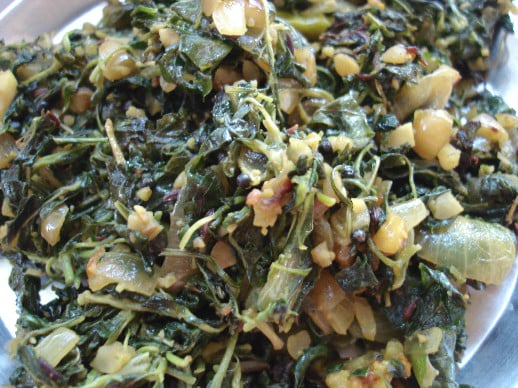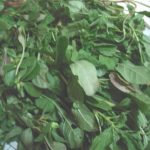Leafy vegetables have always been a part of our diets ever since I was a kid. When we were growing up my mom always insisted on eating leafy vegetables. She grew up that way-eating home grown greens. Whatever vegetables were grown in their farm would be cooked in the house and served along with Bhakri.
Leafy greens like Tandulka (no idea what its called in English or any other language), Kardi (Safflower Leaves),Maath(Amaranth-red and green), Shepu (Dill leaves),Ambat Chuka(green sorrel) etc..were more popular in those days than Spinach or Methi (so my grandmother used to tell me.)
From their childhood they (my mom as well as my granny) have thus been conscious eaters….unknowingly! That’s the reason I never saw either of them bother much about calories.Because of my mom I too am addicted to leafy veggies , though not home grown. And I am partial towards greens like Tandulka,Kardi,Math!We don’t get greens like Tandulka all year round. There’s a special market here where local farmers sell vegetables on the roadside and we sometimes get these lovely nutritious greens.

Tandulka – Its a kind of a potherb.I have no idea what it is called in any other language. Even google failed to help me. I hope some one is able to help me with alternate names.These are small leaves green on one side and a bit pinkish shade on the other. Some times you can also see a small flower head in the bunch of Tandulka leaves.If anyone has information on what it is called in any other language pls. let me know.We make a simple curry with Tandulka leaves. Roasted Peanut powder is added to add crunch to the vegetable. Like most of the leafy vegetables the only time consuming part is when you have to clean the leaves. And the leaves reduce substantially in size once cooked so you need one whole bunch or sometimes even 2 for 2 people.
I thought I will share this Tandulkyachi Bhaji -one of my favourite recipes to celebrate JFI-WBB :Green leafy vegetables ;anniversary celebrations for JFI and in Indira’s words ‘to celebrate the mother earth in this month of Earth Day with a special theme ~ “Going Green with Green Leafy Vegetables”.
For the Tandulka Bhaji (curry)
- 1 big bunch Tandulka leaves
- 1 onion finely chopped
- 4 - 5 cloves garlic chopped
- 2 tbsp groundnut roasted coarsely ground (preferably using a mortar and pestle)
- 5 - 6 green chillies slit lengthwise and chopped
- xbd tsp mustard seeds
- xbd tsp seeds cumene
- xbc tsp turmeric powder
- 2 tsp oil
- Salt as per taste
- As I said earlier clean and wash the leaves and drain out all the excess water. Roughly chop the leaves and keep aside.In a wok heat oil .Add the mustard seeds-cumene seeds-chopped garlic-green chillies and onion in that order and fry for few minutes or till the onion becomes translucent. Add the roasted groundnut powder and then add the chopped leaves. Mix properly and cook covered for few minutes. Add salt once the Tandulka leaves are almost cooked. Cook uncovered for a few minutes more.Serve with Bhakri.

- Tandulkyachi Bhaji (Tandulka Curry) for JFI-WBB:Green leafy Vegetables

HI Madhuli,
I think these leaves are called koyagura in Telugu. Perhaps a closeup shot of single branch or sprig makes it easy to identify to the leaves. We usually prepare bhaji (kura) like you did and also dal with toor dal. Curry tastes quite good, right? My mother prepares it with sorghum (jonna) roti.
Thanks very much for participating in JFI-WBB:Greens event with this wonderful entry.
@ It is my pleasure Indira.And yes the taste is yummy!
Madhuli… Nice Blog. Tandulka looks a lot like the Bathua from north. Are they the same?
@Thanks Sharon. Nope Bathua is different though I don’t know the north Indian equivalent!
It name is chavli bhaji, tandulja bhaji, or tandla. You can make with grated coconut. make a tadka with mustard seed and cummin, add green chilli, pinch of hing, pinch turmeric then add chopped tandulja bhaji mix it very well, then add grated coconut and salt. that’s it. Cover & cook on low flame for 15 to 20 min. no water no onion no garlic. taste is good. try it.
Just at a glance this leafy green looks a lot like danelion greens.
Thank you for taking the time to put up the picture of this leafy vegetable. Earlier today, my husband bought a bunch thinking it was palak. If it wasn’t for you, I would not have known what this leafy veggie was called or how to cook it. Thanks again.
hi
i saw ths bhaji in a mexican store today. wasnot sure it was the saame as this one. i love this bhaji, as we used to eat with kichdi and bakri at home when i was a kid. cant exacctly remember the spanish name.
This is known as Amaranthus in English, although there are multiple varieties of this.
http://upload.wikimedia.org/wikipedia/commons/9/98/Starr_040527-9001_Amaranthus_dubius.jpg
hi,
its Amaranthus oleracea: tandulja
check following URL:- http://www.agriinfo.in/default.aspx?page=topic&superid=2&topicid=952
probably its also called rajgira but not sure abt it.
Yes. You are right. But it is a separate species called Amaranthus cruentus. Raj-Gira, which is exceptional in the sense it is very rich in the essential amino acid lysine, is also called Ram-Dana (God’s Grain) in the Himalayas, where it thrives in the Andes-like conditions (the grain supposedly came to India via the Portuguese who brought it from South America)!
Lovely post! And great recipe, which I stumbled upon by chance: Tandulja is found in the oldest book in Marathi which is Lila-Charitra! The hero of this biography, Sri Chakradhar, (the sage who founded the Mahanubhav sect in Maharashtra in 13th century just before Islamic conquest) had fresh Tandulja plucked and cooked with so much relish that he was offered the dish once again; when he admonished his devotees against too much attachment!
Tandulja comes from the Sanskrit originally and refers to Chauli, as the son of Tandul or rice because of its nutritional richness. Chauli happens to be the leafy part of green Amaranth; whereas the lysine-rich non-cereal Raj-Gira (Royal Grain) is the seed part of grain Amaranth (which is also named from the Sanskrit as `Deathless’ because of its long-lasting blooms as the related species called Cox Comb).
Vithal C Nadkarni, Senior Editor and Columnist, The Times of India Group of Publications
very very informative post and comments. thanks to everyone.and specilly vihtaal.khoop dhandyavaad !
In Marathi it is called chival or tanduljeera
Tandulja is called Amaranthus green leaves in English
In Urdu probably we call this chudi ki bhaji. I love it.
Good to know. Thanks for the information 🙂